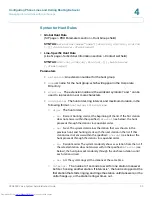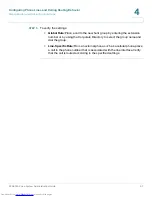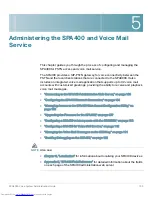
Configuring Phone Lines and Calling Routing Behavior
Managing Inbound Calls with the Contact List
SPA9000 Voice System Administration Guide
90
4
EXAMPLE
:
4085555550:aa|4085101|4085102|408510
3|4085104|4085500|
•
Enter a plus (+) or a minus (-) before the extension number to achieve the
desired results for caller ID and call routing:
•
+ <Extn1>
The extension will be alerted when there is an incoming call to
the DID number, and the DID number will be used as the local user-ID in
outbound SIP requests, along with the display-name of the extension.
•
- <Extn1>
The extension will not be alerted when there is an incoming call
to the DID number. However, the DID number will be used as the local user-
ID in outbound SIP requests, along with the display-name of the extension.
DIDn#: DID number, matching the format of the number signaled in the SIP
trunk
•
Extn#: Target extension number or
a
for Auto Attendant
•
Default route: The default route (extension, hunt group or Auto Attendant) to be
used in case the incoming target number does not match any of the DID
numbers in the contact list with the format described in the sections above.
•
Call forwarding: Optionally, add call forward information to the Contact List to
specify how unanswered calls are handled.
It is useful to add call forward information to ensure that calls are answered
when the designated phone is unstaffed, as may be the case during lunch time
or after hours. In this case, if the call is not answered within a specified time, the
call is routed to another phone or to the Auto Attendant.
SYNTAX:
<DIDn1>:+<Extn1>,cfwd=<target>|<DIDn2>:+<Extn2>,cfwd=<targ
et>|<DIDn3>:+<Extn3>,cfwd=<target>
EXAMPLE:
4085555550:aa|4085101,cfwd=aa|4085102|4085
103|4085104|4085500|
Downloaded from
www.Manualslib.com
manuals search engine






























